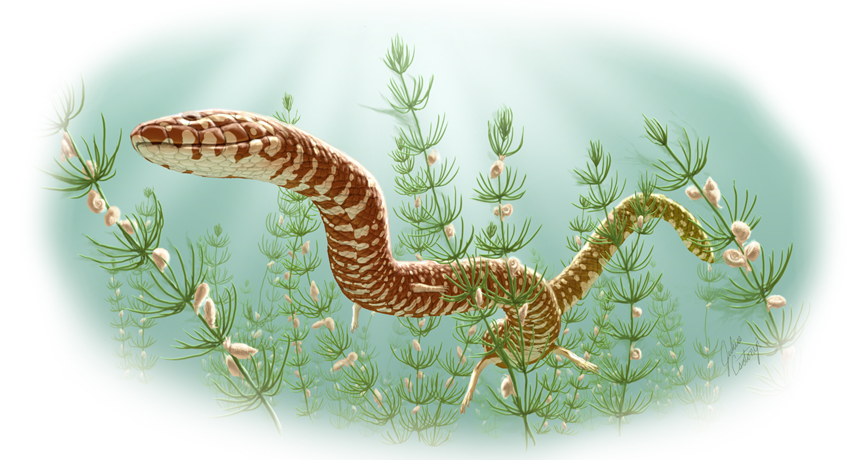Snakes may have slithered amongst Jurassic dinos
Newly analyzed fossils suggest the earliest snakes appeared 70 million years earlier than previous estimates

What had four legs and wriggled among the dinos? Ancient snakes. A new study pushes back the date of the oldest snakes by 70 million years.
JULIUS CSOTONYI
The oldest known snake held a sssssurprising secret: its age. A new study of ancient snake skulls suggests this animal may have been around 167 million years ago. That would mean it likely slithered during the Jurassic Period. For perspective, that would have been roughly 100 million years before Tyrannosaurus rex ruled.
Until now, the record fossil snake was 100 million years old. Its bones turned up in Africa. A new analysis now pushes back the date for the earliest snakes by 70 million years.
To establish the new record, scientists studied the cranial remains of four ancient species. These snakes lived in regions that are now Portugal, England and Colorado. Their skulls had features similar to modern snakes, the researchers reported January 27 in Nature Communications. Both the ancient and modern animals had flexible skulls, which would have helped them gulp down bulky prey.
Scientists who study snakes had assumed “the long body evolved first,” he notes. “It allows constriction, an ancient predation strategy.” A highly mobile skull would have come later, he told Science News. But the new study’s authors now “challenge this,” he says, “and present a new head-first hypothesis.”
Michael Caldwell is a paleontologist at the University of Alberta in Canada. He has been working on the new analysis of ancient snakes for more than a decade. This project began while he was examining lizard fossils from England. At one point he came across snake bones from the Jurassic Period.
That discovery made him wonder if other ancient snakes had been overlooked in fossil collections. So for 10 years his team searched other museum collections. Their hard work paid off. The researchers found four new species of snakes. All were between 143 million and 167 million years old.
Those ancient animals most likely still had four small legs, Caldwell told Science News. However, they already had developed their special skulls. Skull shape, and not the legless body, was the feature that gave snakes an early survival edge, the new study suggests.
Indeed, Caldwell notes: “Snakes have very mobile skulls.” Besides being flexible, the ancient skulls — like in modern snakes — had teeth that curved backwards. That helped them hold fast to wriggling prey.
Caldwell and his team based their study only on skull fossils. That means they know little about what the rest of the body looked like. (The researchers assume that they had four legs because snake species that lived tens of millions of years later had hind legs.) But even looking only at head fossils can help scientists answer questions about how life has changed over vast periods of time.
“With only bits of skeleton to work with, it’s easy to make a mistake,” cautions Nicholas Longrich. He’s a paleontologist at the University of Bath in England. Still, he told Science News that Caldwell’s team makes “a good case for these fossils being related to snakes.” In fact, he adds: “These fossils are the best candidates we’ve seen yet for early snake relatives.”
Power Words
(for more about Power Words, click here)
cranium The part of the skull that protects the brain. Used as an adjective, the term would be cranial.
dinosaur A term that means terrible lizard. These ancient reptiles lived from about 250 million years ago to roughly 65 million years ago. All descended from egg-laying reptiles known as archosaurs. Their descendants eventually split into two lines. They are distinguished by their hips. The lizard-hipped line became saurichians, such as two-footed theropods like T. rex and the lumbering four-footed Apatosaurus (once known as brontosaurus). A second line of so-called bird-hipped, or ornithischian dinosaurs, led to a widely differing group of animals that included the stegosaurs and duckbilled dinosaurs.
evolution A process by which species undergo changes over time, usually through genetic variation and natural selection. These changes usually result in a new type of organism better suited for its environment than the earlier type. The newer type is not necessarily more “advanced,” just better adapted to the conditions in which it developed.
evolve To change gradually over generations, or a long period of time. In living organisms, the evolution usually involves random changes to genes that will then be passed along to an individual’s offspring. These can lead to new traits, such as altered coloration, new susceptibility to disease or protection from it, or different shaped features (such as legs, antennae, toes or internal organs). Nonliving things may also be described as evolving if they change over time. For instance, the miniaturization of computers is sometimes described as these devices evolving to smaller, more complex devices.
fossil Any preserved remains or traces of ancient life. There are many different types of fossils: The bones and other body parts of dinosaurs are called “body fossils.” Things like footprints are called “trace fossils.”
hypothesis A proposed explanation for a phenomenon. In science, a hypothesis is an idea that must be rigorously tested before it is accepted or rejected.
Jurassic Lasting from about 200 million to 145.5 million years ago, it’s the middle period of the Mesozoic Era. This was a time when dinosaurs were the dominant form of life on land.
paleontologist A scientist who specializes in studying fossils, the remains of ancient organisms.
paleontology The branch of science concerned with ancient, fossilized animals and plants.
reptile Cold-blooded vertebrate animals, whose skin is covered with scales or horny plates. Snakes, turtles, lizards and alligators are all reptiles.
species A group of similar organisms capable of producing offspring that can survive and reproduce.







